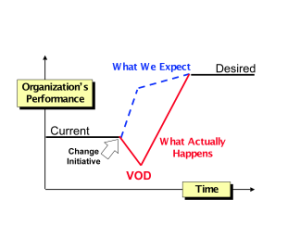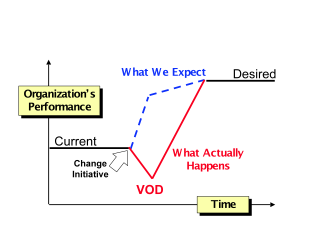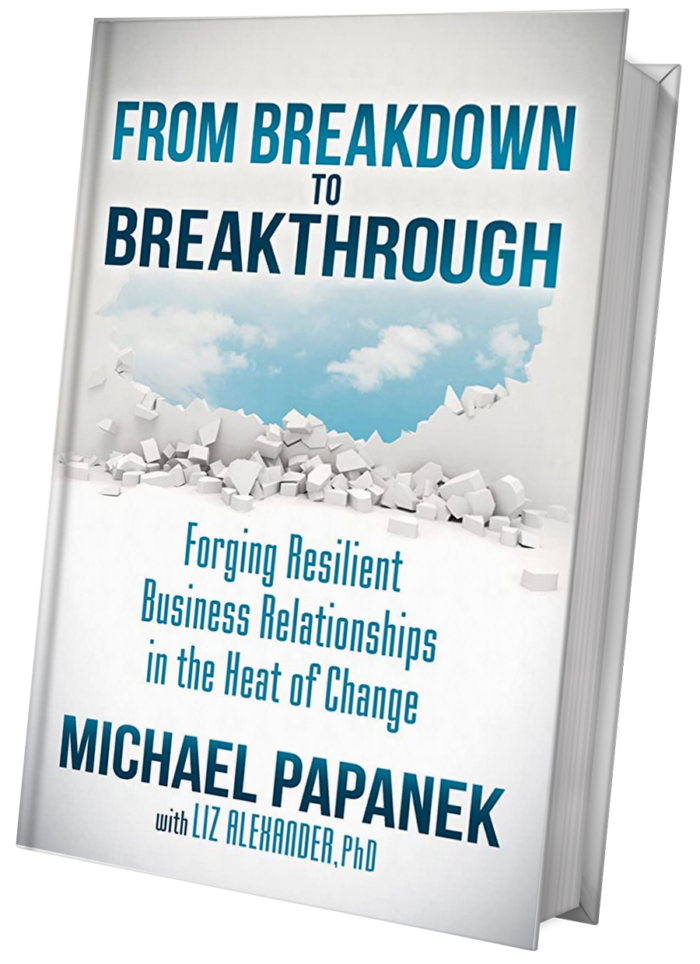 Anyone who has implemented a change is familiar with an early phase that tends to come right after “launching” the change. This is supposed to be an exciting time, yet sometimes no one seems happy: not the executive sponsors, not the change team and not the impacted stakeholders. You thought everyone had bought-into the vision and was excited about the change! What happened?
Anyone who has implemented a change is familiar with an early phase that tends to come right after “launching” the change. This is supposed to be an exciting time, yet sometimes no one seems happy: not the executive sponsors, not the change team and not the impacted stakeholders. You thought everyone had bought-into the vision and was excited about the change! What happened?
What is happening to you is not the end of the world and does not have to be the end of your project (or career). You are just experiencing what we call “The J Curve” of change (see below).
Study this well, because if you do not manage this curve the right way, the dip in the J could become the final resting place of your project, known as “The Valley of Death” (VOD), where change initiatives go to die.
Change we can believe in?
When implementing a change, whether it is a new IT system, a new product or a new compensation plan, we usually spend some period of time at the beginning of the change effort on what we call the vision or the desired end state. This is extremely valuable because it gives us inspiration and motivation to change and identifies the gaps between today and the future. However, focusing on this vision can create unreasonable expectations among the stakeholders.
People hear about (and hopefully help create) the exciting new vision, and they get very excited about the benefits. Most people expect things to start improving immediately (“at last we are dealing with this!”). Inevitability, however, there is a time at the beginning of the change when productivity or other results we are focused on go down instead of improving.
This is due to the disruption caused by the natural process of learning and implementing something new. The bigger the change, the more disruption you will experience. So the very thing you want to improve gets worse.
“How long, how deep?”
I was working recently on a large IT transformation and the CIO told me “ I understand about the J curve, and the executive board gets the concept, but they will not tolerate decreased performance for very long. The real question is, how can we make the curve as short and shallow as possible? How can we sustain the change past the dip?”
The stress of complex change with big goals, tight deadlines and strict budgets can become too much during the “dip” in the J. Even the most well intentioned leaders can become frustrated because they feel caught between the high expectations they set to justify the costs of the change and the resistance or lack of progress they perceive to be happening.
Leaders can make the situation worse by pushing too hard during this phase and thereby prolonging it. Employees are reminded, yet again, of the vision and how important it is. Town Hall meetings are held, emails are crafted and distributed, middle managers are pressed to do a better job “cascading”, employees are told to hurry up and tune into “WIFM” (what’s in it for me).
Some managers, hearing the message from above, may even push employees to “get over it”, or “get on the bus” with the clear implication that those who do not get on will be run over.
Unfortunately, this behavior cuts off honest communication between the stakeholders, drives any real barriers to change underground, and stifles ownership of implementation.
The First Rule of Holes: Stop Digging
Do not make these mistakes and dig an even deeper hole for your change effort. If you instead help everyone anticipate this phase, you can minimize the impact of the J curve and keep your project alive and well.
To avoid letting the dip in the J curve become the Valley of Death, use the following strategies:
Make sure all the key stakeholders, including executive sponsors know about the J curve and are prepared to recognize initial issues as part of the change process, not evidence of disaster.
Identify potential problems in advance, remove the ones you can and mitigate the others (postpone other changes so they do not all hit at once, obtain advance funding for added temporary costs, prepare customers for the change, have a team in place accountable for tracking and resolving problems, develop back-up plans).
Provide multiple sources of support for the change: technical, social, educational, physical, emotional. Successful change is usually supported by the application of a number of overlapping strategies and not by finding the one silver bullet.
Remain calm and focus on solving problems so people can change. Never kill the messenger when learning “bad” news. Rather, reward the identification of problems with resources and energy to create solutions.







